Custom boat building is alive and well in New Zealand, and Lloyd Stevenson Boatbuilders is unquestionably one of the most active and versatile. The full custom Artnautica 60 is one of the latest examples completed by LSB and reflects their exceptionally high standards of craftsmanship and bespoke building.
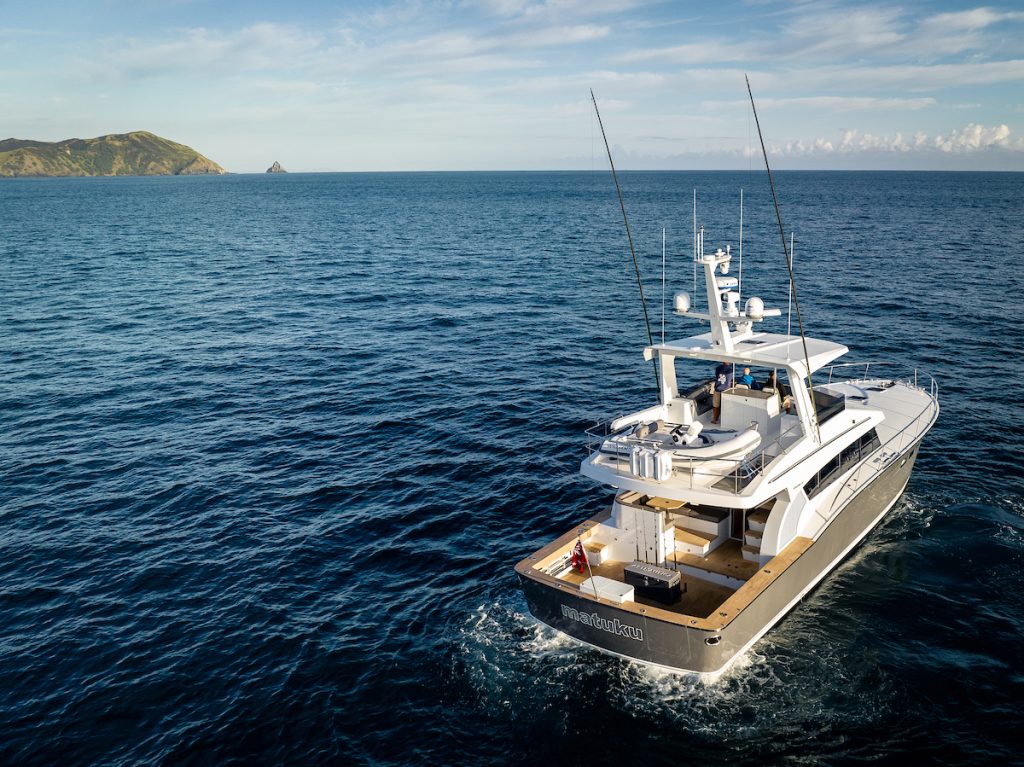
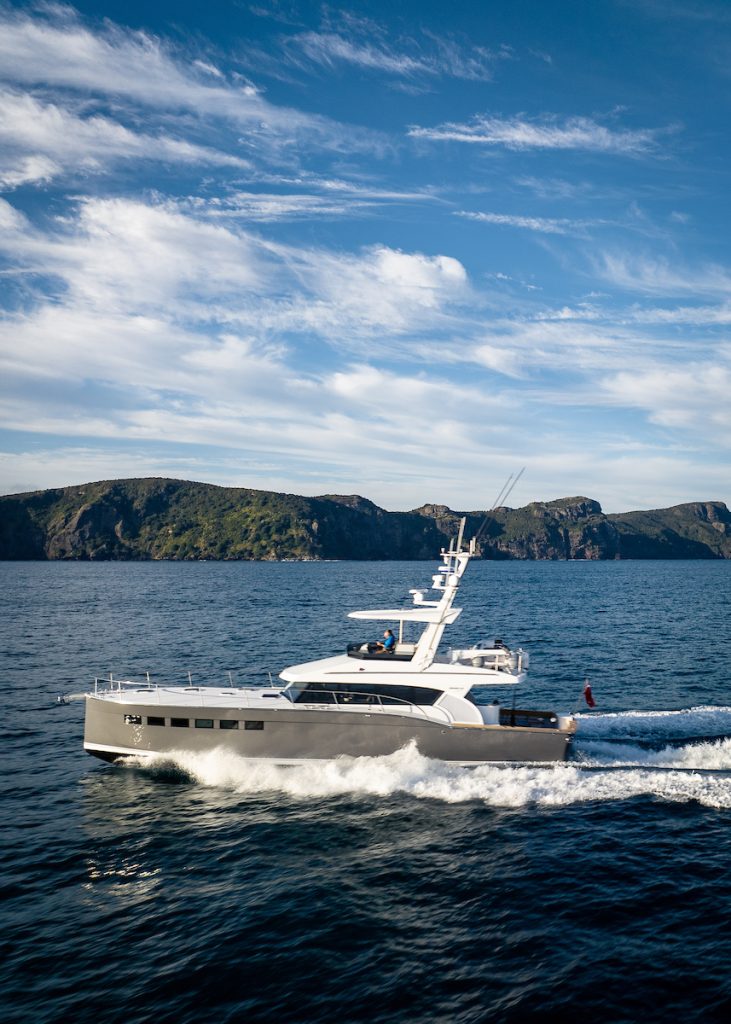
When the owner of Matuku first approached designer Dennis Harjamaa, his requirements were quite specific. “He started with a clean sheet of paper with four things in mind – a sports fisher, a passagemaker, a family floating holiday home and a dive platform. Not too much to ask, I wouldn’t have thought”, says Dennis.
Then there was the wish list which started with an 18m length overall and a lightweight boat powered by Volvo Penta IPS engines, and it needed to get to Fiji at 10 knots without carrying extra fuel. The layout requirements call for a spacious cockpit for stand-up game fishing, an open flybridge with low weight and reduced CofG, plus anyone in the saloon must be able to see the horizon from wherever they were sitting. He also wanted a smooth curved transom with no swim platform.
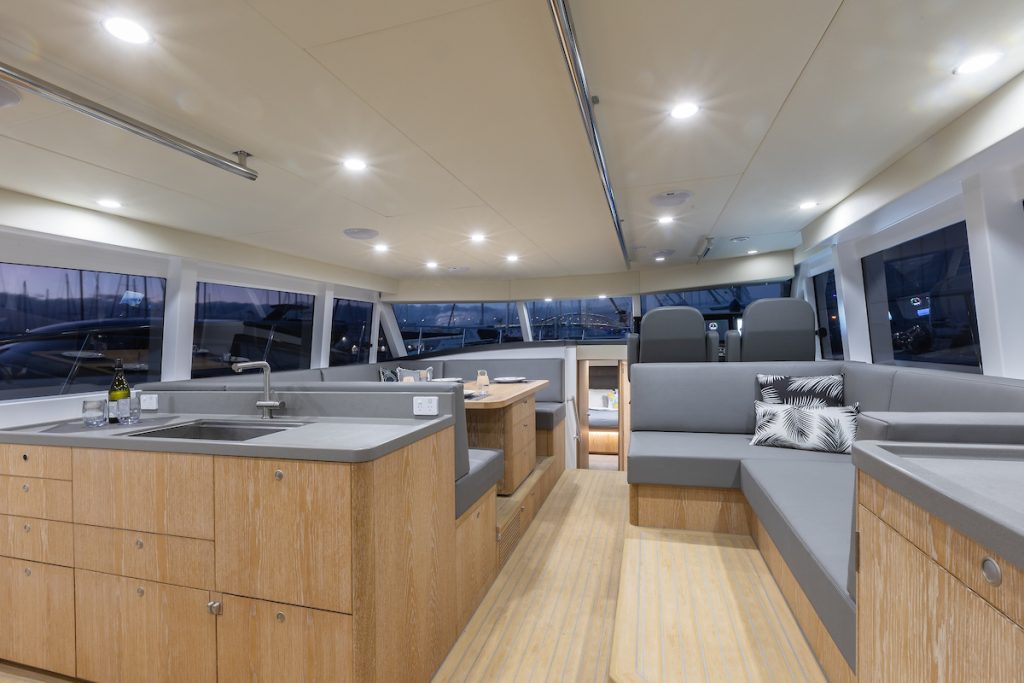
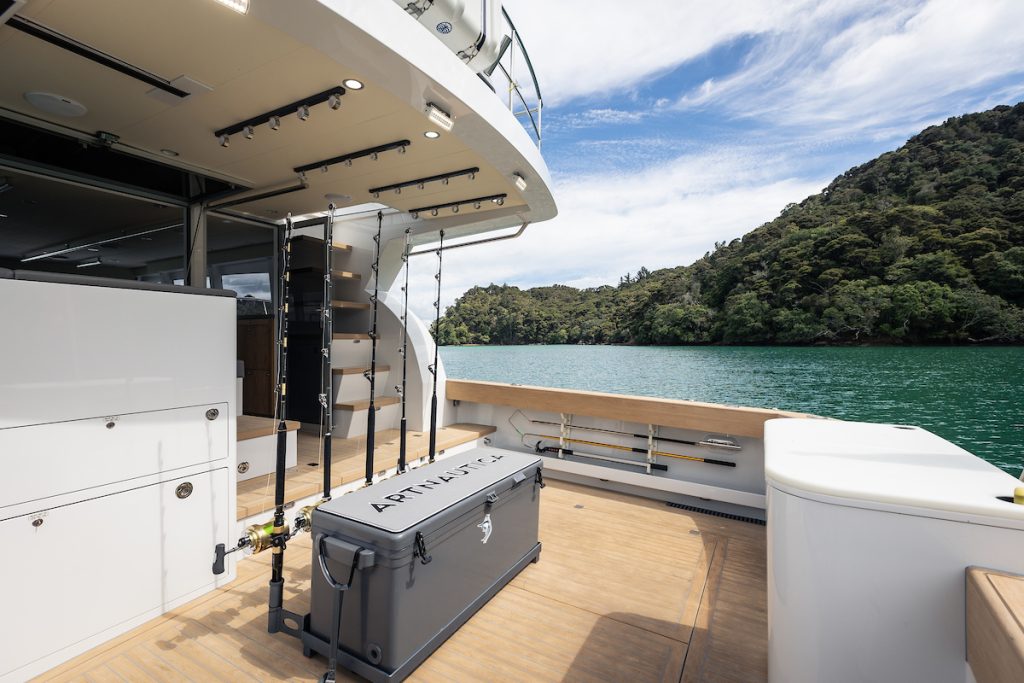
Harjamaa’s response was, firstly, to achieve the lightweight, the boat would need to be built 100% carbon fibre with a mix of infusion and pre-preg. Interestingly the trade-off of building in carbon fibre is that while there is a substantial increase in material costs, these are largely offset by the reduction in labour cost and the time to build the boat.
“Matuku was built like a modern race-yacht with every single item having a weight budget and being weighed on and off the boat during construction. Also, the decision to go all carbon fibre still kept us below the contractual budget,” added the owner.
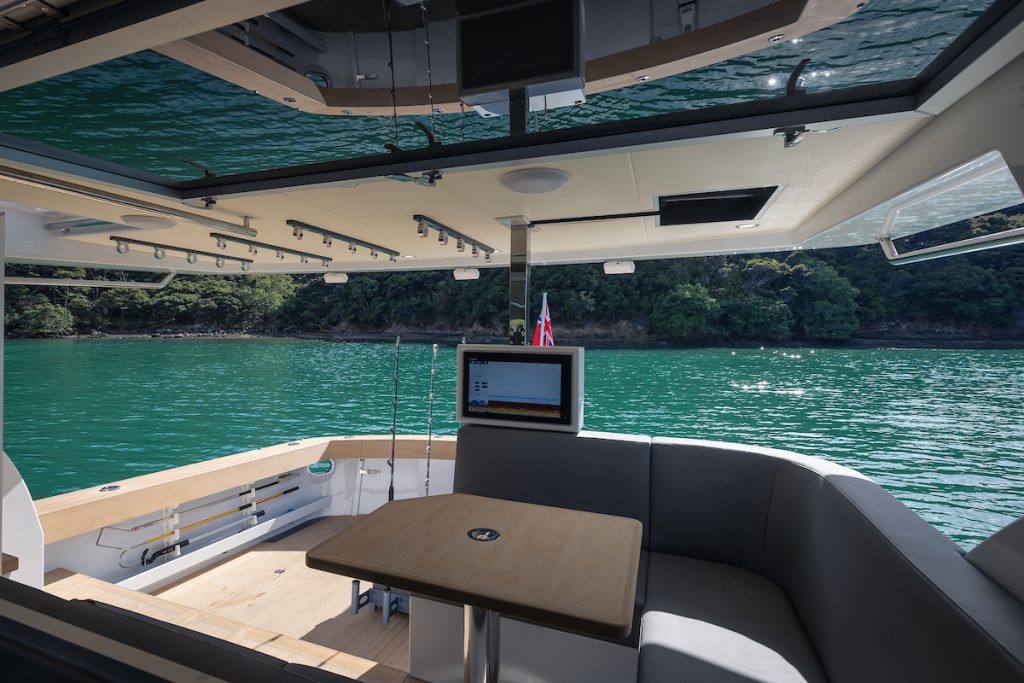
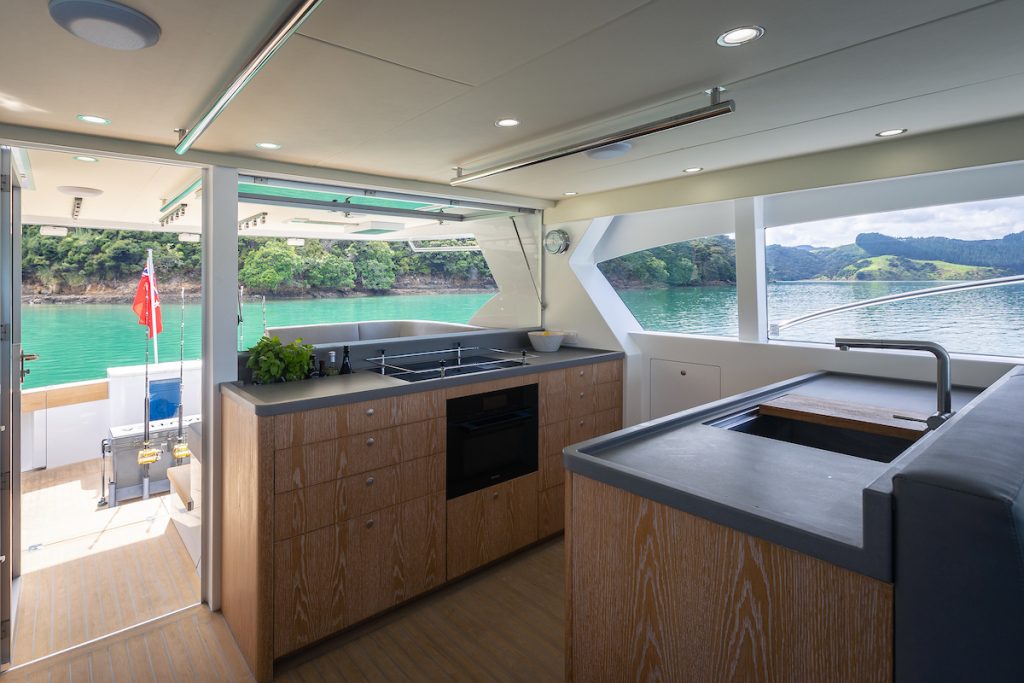
The Artnautica 60 (Matuku) design called for a cruising speed in the mid-20 knot range and long-range capabilities in displacement mode. Along with the open flybridge, an important design criterion was a dry ride at both planing and displacement speeds.
“The way to achieve easy planning is to minimise weight and to maximise the planning surface area. The long waterline one gets with the plumb bow is essential for high displacement speeds, and keeping the waterline entry sharp smooths out pitching motion. The high chine, in combination with the pronounced topsides knuckle line and rub rail, all work together to knock down spray’” explains Dennis.
FIJI, NO WORRIES
One of the owner’s requests from the first brief was he wanted to be able to cruise the 1500nm to Fiji at around 10 knots without adding extra tankage. Matuku will do that and more with a range of about 2000 nm at 10-11 knots. Power is a pair of Volvo Penta D11 IPS 800, producing 625hp each. Maximum speed is just over 30 knots @ 2450 rpm, which returns a fuel burn of around 7.4 l/Nm. However, that’s not where Matuku will spend most of its running time. The optimal cruise speed is around 23 knots, using 6.5litres per nautical mile, giving an approximate range of 830 nautical miles. At a trolling speed of 8 knots, consumption is only 20 lph or 2.35 l/Nm and a range of around 2400nm.
Matuku is the result of a collaboration of not only the owner and designer but also a group of like-minded experienced boating friends who enjoy their fishing and cruising and know what they want in a boat this size. Many elements of the boat have come from a vast pool of people. The owner reflects on their many discussions to achieve what he feels is a near-perfect boat that has fulfilled every criterion he wished for.
GREAT VISIBILITY
The design brief for the saloon has certainly been meet with high profile side windows with narrow mullions giving everyone in the saloon almost unbroken views outside. The raised fore and aft lounging spaces are at a perfect height. With weight still a consideration, all the interior cabinetry is foam with a blonded oak veneer finish, with Flexiteek used on the cabin sole, cockpit and coamings.
The aft galley has Miele appliances, Hi-MACS surfaces, an Isotherm fridge and freezer drawers. Opposite is the L shape settee that converts to another berth when required. The layout of Matuku is very much what the owners wanted, and the designer is quick to add that you can have just about anything you want.
Two large leather Llebroc seats dominate the helm, which features a trio of 16” Furuno glass screens. There’s a pair of Black Box VHF radios and controls for all the onboard equipment, such as Humphrees interceptors, Fusion head deck, Flir camera and HP watermaker. Four large wipers are tucked out of sight under the eyebrow above the screen.
The entire main deck becomes a glorious indoor/outdoor living space with the rear door and window open. An external staircase provides access to and from the open flybridge, with the raised upper deck offering coverage from the weather. A perfect area to enjoy a drink, have a meal or watch the action in the cockpit.
The rest of the self-draining cockpit is all about fishing. The owner is into his stand-up game fishing, so there’s no chair. This is serious stuff, so the cockpit reflects that. Tuna tubes and live bait tank, naturally. There is no boarding platform and a single transom gate. Deck fittings are all recessed or flush, and anything to do with fishing tackle, bait or wet storage is handy and easy to access. The cockpit has been designed to have two people hooked up with plenty of room to move around.
A deck hatch aft gives access to the twin Volvo Penta D11 IPS 800s, with another forward leading down to a large utility space. This comes with a watermaker, gensets, a diesel heater, a freezer, dive bottle racks, and a dive compressor, and a pair of Njord fuel polishers. Had the owner gone for the full beam aft master option, this space would not have been available.

FORWARD MASTER
Matuku has been designed with three cabins and two heads to sleep six and has an overflow capacity for at least two more. In contrast, the initial brief was for a full beam master, which meant raising the saloon sole and the flybridge. Harjamaa persuaded the owner that this would compromise the sleek low profile aspect of Matuku, so a master forward was chosen.
The owner wanted to keep the CofG as low as possible, so raising the cabin was not an option. Hence, the master stateroom is forward, with a central king-size berth with easy access on both sides, plenty of storage for drawers, under the berth and hanging lockers and, of course, a private ensuite. The headroom throughout all the cabins is 2m, and all are individually zoned with Webasto air con. Heating is provided from a Post diesel boiler, which provides heating and hot water, and saves running the genset or engines.
There are guest cabins on both sides of the companionway, and being a custom boat, how you configure the sleeping arrangements is up to you. Matuku has a double to port with two singles that slide together in the starboard guest cabin. The guest cabins share the same head/shower, doubling as the day head. Both ensuites have large shower stalls and heated ceramic tiles on the soles.
OPEN BRIDGE
As Matuku is not a 100% Sportfisher, the flybridge helm is well forward and not aft, as you would expect from a serious game fishing boat, instead utilising that space for the Williams Jet Tender dinghy stowage and as a social area. There is a third driving position in the cockpit, so the angler and the skipper can be close together in the same space when a fish is on.
There are L shape settees on either side of the central forward helm, and while there is a reverse sheer low profile screen, there are no clears. If the weather gets nasty, the skipper can run the boat from the lower helm.
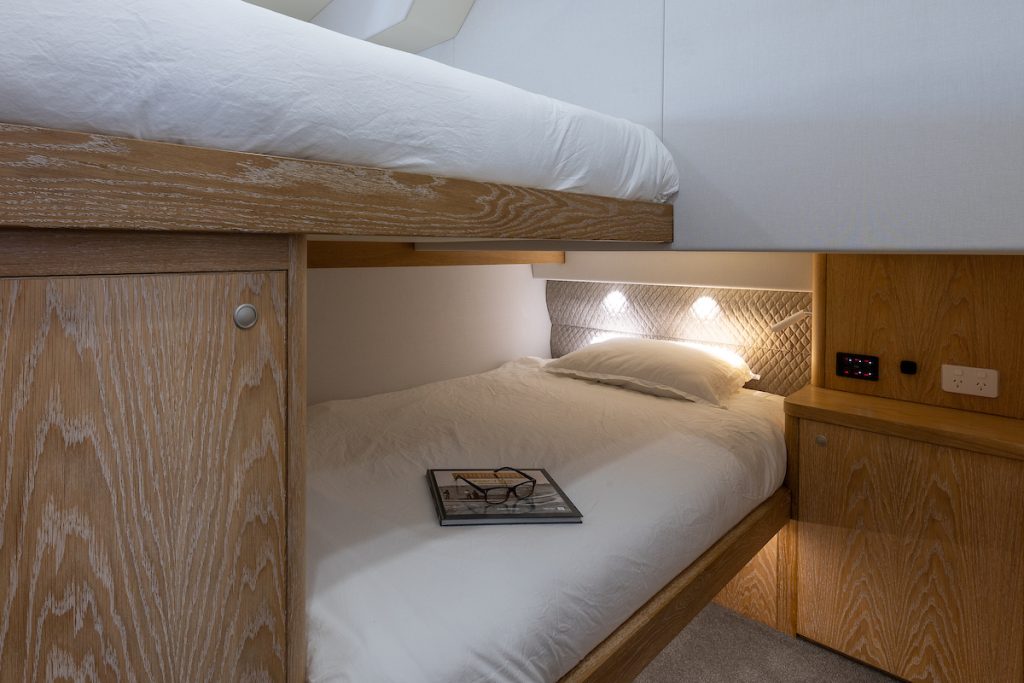
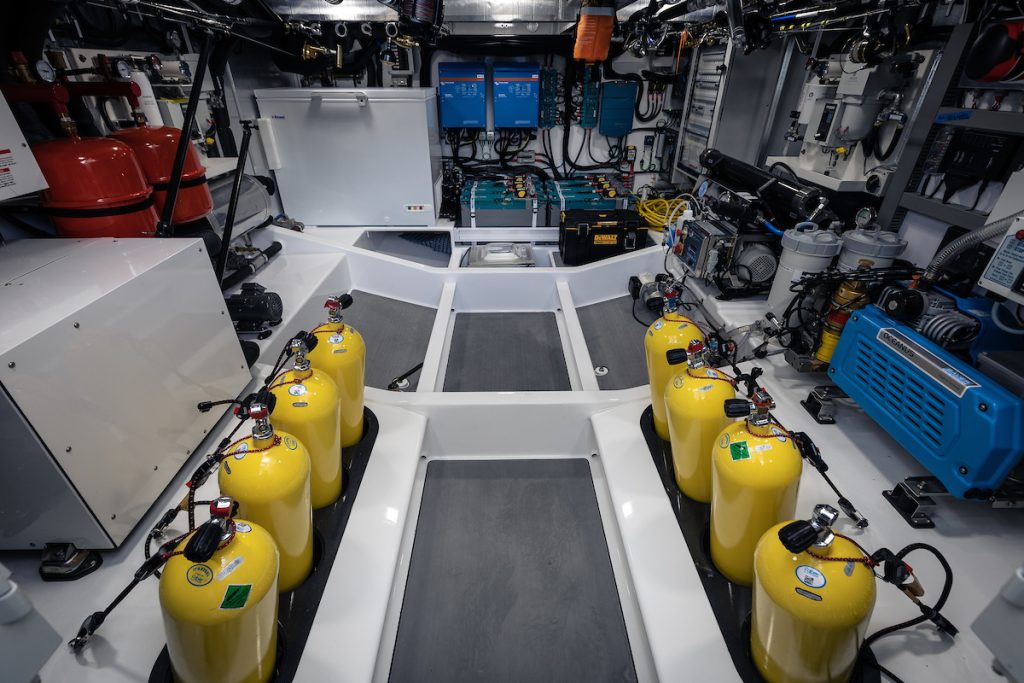
LET’S CRUISE
Matuku blends meticulous craftsmanship, a practical layout and a super-efficient hull form into one exceptional package. A compromise maybe, but it meets the owner’s objectives in all respects. After a Kiwi summer, plans are to cruise to exotic destinations such as Fiji, New Caledonia, the Kermadecs and even a circumnavigation of New Zealand. The Artnautica 60 is the perfect vessel for all those adventures.
Performance Data : 2 x Volvo Penta D11 IPS 800
| rpm | Knots | L/h | L/NM | Range (NM) |
| 600 | 6.2 | 10 | 1.6 | 3375 |
| 1000 | 9.7 | 30 | 3.0 | 1800 |
| 1200 | 11.2 | 49 | 4.3 | 125 |
| 1400 | 12.6 | 71 | 5.6 | 964 |
| 1600 | 15.1 | 95 | 6.3 | 857 |
| 1800 | 18.9 | 119 | 6.3 | 857 |
| 2000 | 22.3 | 146 | 6.5 | 830 |
| 2200 | 26.0 | 179 | 6.8 | 794 |
| 2400 | 29.5 | 205 | 6.9 | 782 |
| 2600 | 32.0 | 240 | 7.5 | 720 |
Note: Range is based on 90% of fuel capacity, in calm conditions.
SPECIFICATIONS
- Boat Design Name Artnautica 60
- Boat Name Matuku
- Year Launched 2022
- Style Sedan
- Builder Lloyd Stevenson Boats
- Designer Dennis Harjamaa
- (Artnautica Yacht Design)
- LOA 18.0m
- Beam 5.6m
- Deadrise 17 deg
- Draft 1.27m
- Displacement (Dry) 22000 kgs (Approx)
- Max Displacement (Wet) 28000 kgs (Approx)
- Max Speed 32 knots
- Construction Carbon Fibre
- Fuel Cap 6000 litres
- Water Cap 900 litres
- Engines Make 2 x Volvo Penta D11 IPS 800
- Drive Train IPS
- Generators 2 x Fisher Panda 21kw
- Air Con Webasto
- Interceptors Humphree
- Lighting Hella
- MFD 6 x Furuno TZT3
- Winch Maxwell
- Flooring Flexiteek
- Tender Williams Sport Jet
- Ent System: Fusion
Classification DnV-GL High Speed Light Craft Open Ocean at 4g Acceleration
Contact lloydstevensonyachts.co.nz
.




